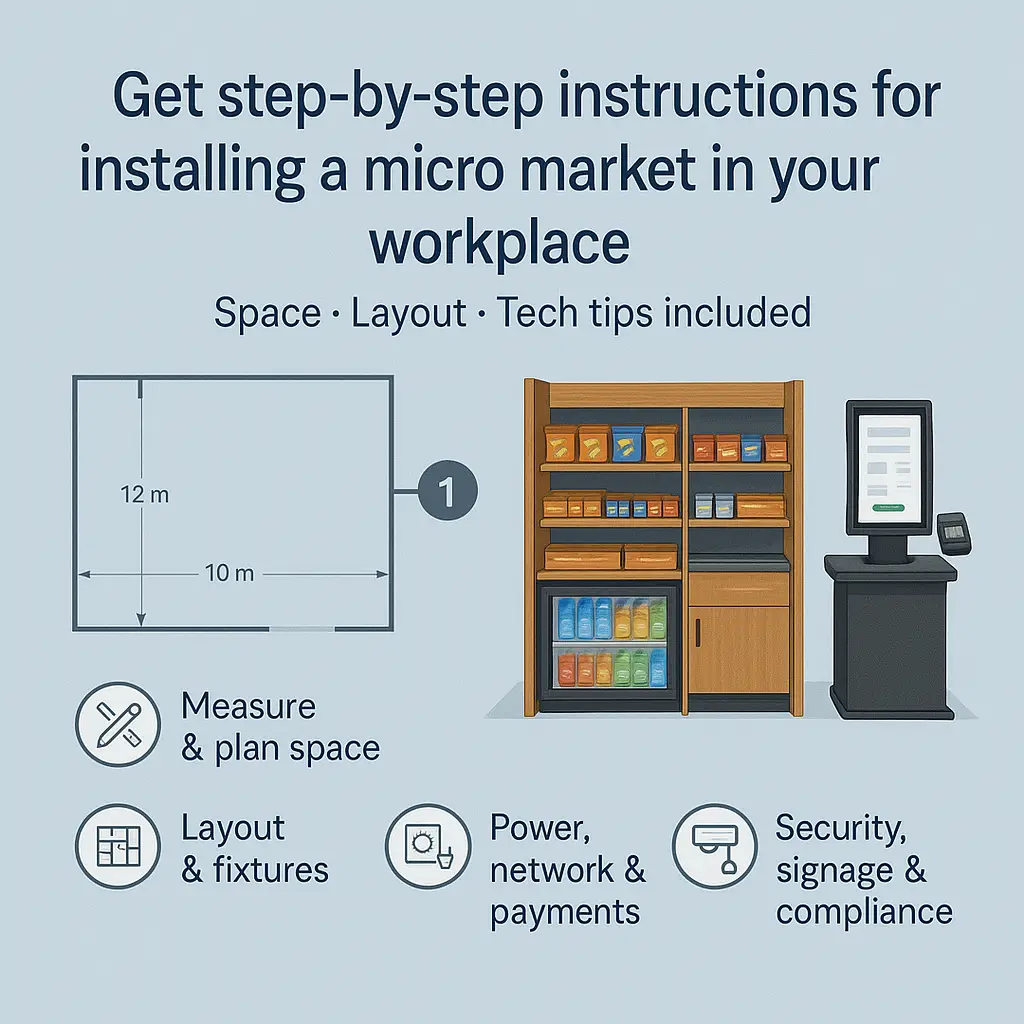Micro Market Kiosk Installation Guide
Get step-by-step instructions for installing a micro market in your workplace. Space, layout, and tech tips included.
Back to Micro Market Services ResourcesGet step-by-step instructions for installing a micro market in your workplace. Space, layout, and tech tips included.
Back to Micro Market Services ResourcesKey factors like foot traffic flow, power access, product visibility, and smart technology compatibility all play important roles in building a successful micro market in your space.
![]() Proper layout maximizes shopper flow and increases usage
Proper layout maximizes shopper flow and increases usage
![]() Smart kiosks require stable Wi-Fi and power access
Smart kiosks require stable Wi-Fi and power access
![]() Correct product zoning improves inventory management
Correct product zoning improves inventory management

Installing a micro market kiosk requires thoughtful planning, especially when it comes to space, layout, and technology. These self-service retail markets function best when placed in high-traffic common areas like break rooms, building lobbies, or employee lounges. The ideal footprint is typically 75 to 150 square feet, offering room for coolers, racks, shelving, a smart kiosk, and comfortable shopper access.
First, assess the footprint available in your location and ensure there are at least two standard power outlets. If you’re setting up an AI-powered kiosk or smart cooler, consistent Wi-Fi is also required for inventory tracking and contactless payment. Some vendors may request a dedicated network—check with your provider to streamline setup.
Next, plan your layout for functionality and flow. Keep beverages closest to the kiosk or check-out area, as these are high-volume items. Snacks and shelf-stable meals do well near eye level in center racks or glass-front displays. Healthy items should be grouped in a dedicated section to appeal to health-conscious users.
Secure installation of all equipment is essential. Coolers must be leveled correctly to prevent noise and cooling issues. The kiosk should be positioned centrally and clearly visible, ideally with signage directing customers to place payment via mobile pay or card. Modern kiosks utilize cameras, smart sensors, and AI systems to manage inventory and reduce shrink risk.
Work with your vendor to understand restocking schedules, maintenance needs, and reporting features. Many providers offer managed service arrangements so you don’t have to worry about tracking inventory or coordinating visits yourself. If you want a hands-off approach, inquire about full-service options.
For added convenience, consider complementary amenities. For example, a coffee station with smart brewers next to your micro market creates a robust refreshment corner. In fitness-focused environments, healthy vending solutions can supplement your micro market.
If you're exploring vending options for your business, Vending Exchange can help simplify the process. Delivery, Installation and Equipment is provided at no cost to you - vendors provide the machines, keep them stocked, and handle all servicing. Whether you need a provider or full-service management, just fill out the form on this page to get started.
Most micro markets require 75 to 150 square feet to fit the kiosk, coolers, racks, and shelving with enough room for customer movement.
High-traffic areas like break rooms, lobbies, and near employee lounges typically deliver more visibility and frequent usage.
Standard 110v outlets are usually enough, but multiple outlets may be needed for coolers, the kiosk, and lighting.
Yes, most smart micro market kiosks need a stable Wi-Fi or ethernet connection for payment processing and inventory tracking.
Common offerings include bottled beverages, snacks, ready-to-eat meals, fresh food, and healthier items like protein bars and low-sugar drinks.
Yes, vendors typically handle delivery, install, and setup of all equipment at no cost for qualifying locations.
Modern kiosks use smart sensors, inventory tracking, and sometimes cameras to reduce theft and maintain accountability.
Vendors handle restocking and maintenance. With managed services, you won’t need to worry about on-site tasks.
Yes, most vendors work with you to create a product mix tailored to your team’s preferences and dietary needs.
Vendors are responsible for all repairs. Many also monitor equipment remotely to address issues before they become major problems.